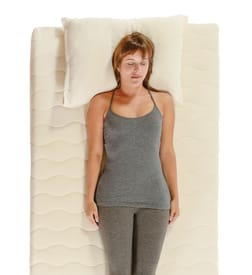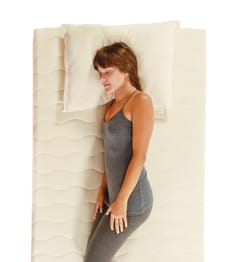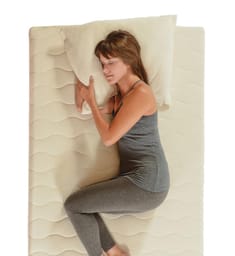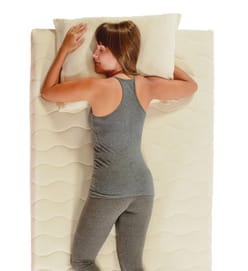Back Pain: How to Help
The CDC indicates that at least 25% of Americans had reported lower back pain in the prior three months. Perhaps you are one of them, as back pain is a prevalent complaint in America. You may wonder, what does my mattress have to do with back pain? Listed here are just a few ways your mattress can impact your back:
- Sleep is a time for your body to restore and rejuvenate itself. Without a comfortable, healthy mattress, it is more difficult for your body to heal.
- Your mattress should provide proper support to each zone of your body so that your spine can be aligned and in a neutral position while sleeping.
- Our sleep position can contribute to back pain or help it to heal
Since we spend roughly one-third of our lives sleeping, having a mattress that supports our back (and the rest of our spine) as much as possible makes sense. Without a doubt, the most common recommendation when looking for a mattress to help with back pain is to keep your spine neutral while sleeping as much as possible.

Keeping your spine neutral while you sleep helps prevent back pain.
The most critical question you should ask yourself when you lie down at night is, "Are my head, neck, and spine all in a neutral position?" Neutral means that your spine is straight, and keeping your spine aligned and neutral starts with your head and neck and goes down. Even things like having your hips/pelvis tilted one way can, in turn, twist your spine. Therefore, ensure that your head, shoulders, and hips are aligned and that your back is adequately supported. See below how a customized mattress with varying firmness can help give proper support and help you have a neutral spine.
What sleeping positions are best if you have back pain?
As mentioned in the last section, keeping your spine neutral is the most crucial consideration, and this is true no matter what sleeping position you choose.
Many practitioners feel that sleeping on your back is best for keeping your spine aligned. (See Photo 1 below) Sleeping helps your weight be distributed evenly and minimizes pressure points. If you sleep on your back, make sure your pillow fills the space between your neck and head to align your spine correctly. In addition, pillows under the knees can be helpful. Finally, you may also need a small pillow or pad under the lower back. Some people find it beneficial to sleep in a recliner or an adjustable bed with the head raised.
Sleeping on your side can contribute to muscle imbalance and pain if your sleep surface does not provide enough support and cushioning. (See photo 2) Sometimes, sleeping in the curved fetal position can help with a herniated disc. (See Photo 3) However, this may cause an uneven distribution of weight that can cause back pain and sore joints. To counteract this, sleep with a pillow between your knees to help keep your spine aligned and neutral. A thicker, gusseted pillow under your head can provide support, so the spine is lined up correctly. Sleeping stretched out rather than curved can help with relaxation if this is comfortable for you.
Some practitioners feel that sleeping on your stomach can exacerbate back pain. (See photo 4) If you choose to sleep on your stomach, a proper pillow that is soft and keeps your neck in alignment with the rest of your spine is very important.
If you sleep on your back, a rolled-up towel or a unique support pillow can help support your back, keeping your spine neutral.

A customized mattress can help keep your spine neutral, alleviating back pain.
Various parts of your body, such as your hips, neck, shoulders, and back, need different amounts of support. Because of this, customizing your mattress may help to reduce or eliminate some everyday aches and pains by keeping the spine aligned. This helps keep the spine neutral, as we talked about earlier. Some mattresses even have customized zones that provide the best support right where you need it.
Click pictures to enlarge
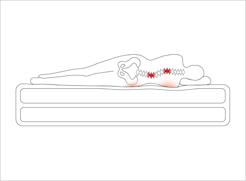
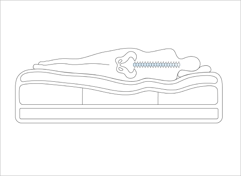
There are several types of customization to look for when evaluating a bed.
You can look for customization by:
- Side – mattresses are not one size fits all, so being able to customize by the side helps each partner to have the support they need.
- Firmness – having a choice of soft, medium, and firm will give your back the support it needs while easing pressure points.
- Zone – some mattresses (such as our Vispring and Obasan) allow you to have a different firmness for feet, back, hip, and shoulder and neck areas.

If you visit a showroom, you will have the opportunity to try various configurations and brands to see what works best for you and the health of your back. Our associates will help you take all the time you need to decide which mattress is the healthiest choice for you.
Your sleeping position and your mattress should help, not hinder, your rest. Look for the most comfortable bed your money can buy! You can spend one-third of your life on a mattress that helps and does not hurt your back.

